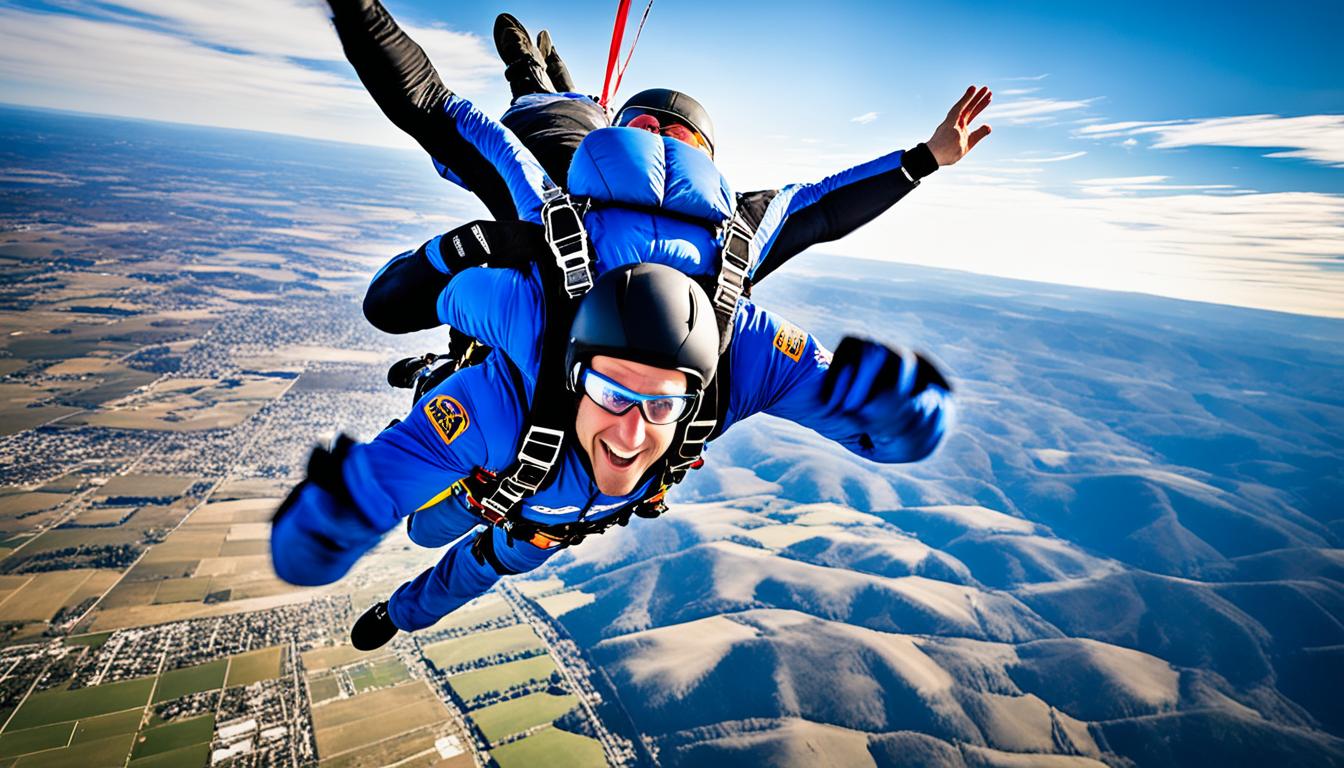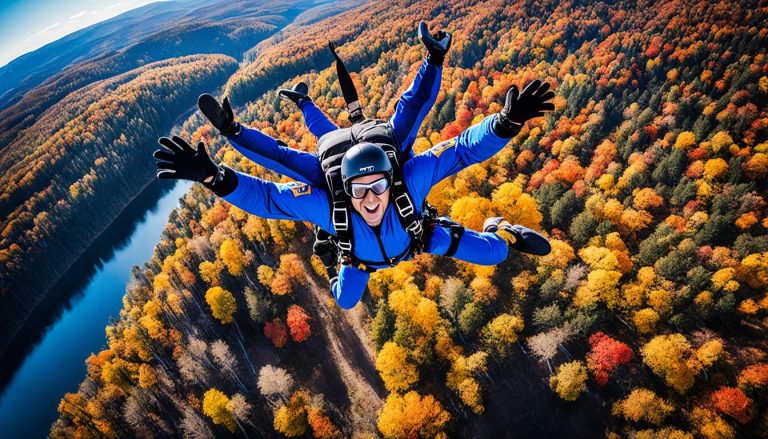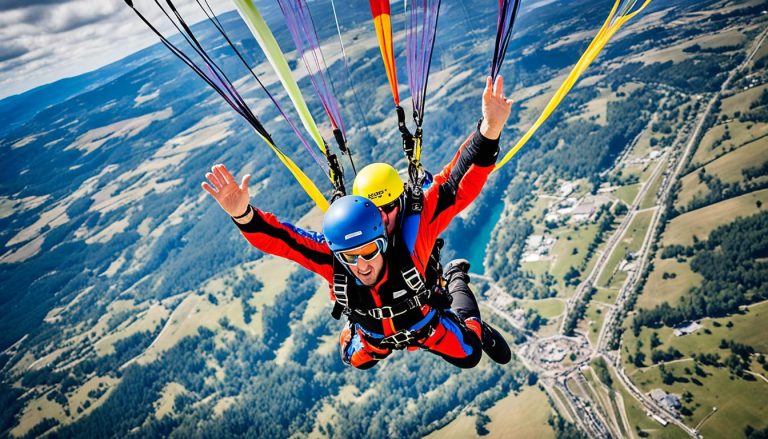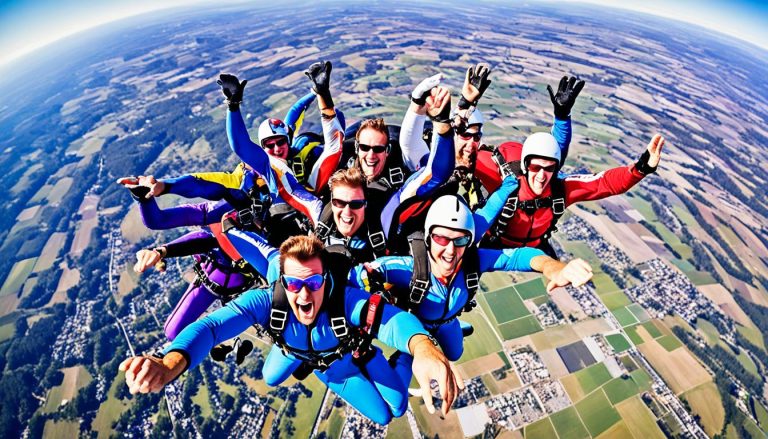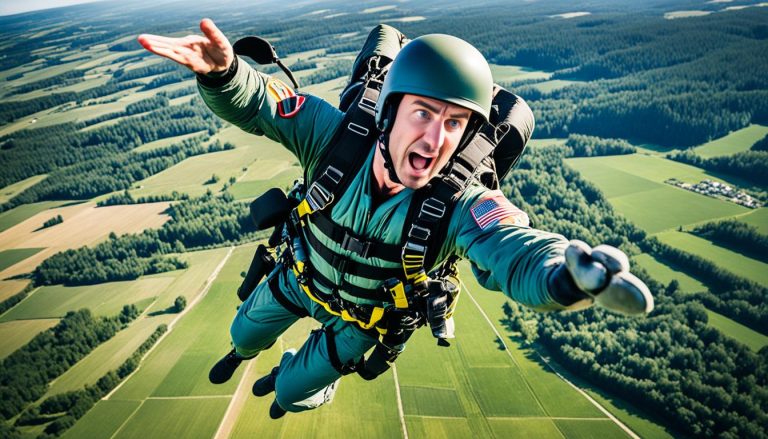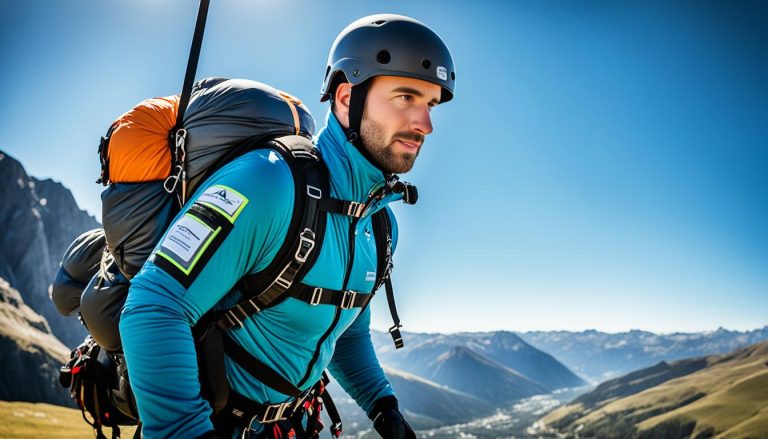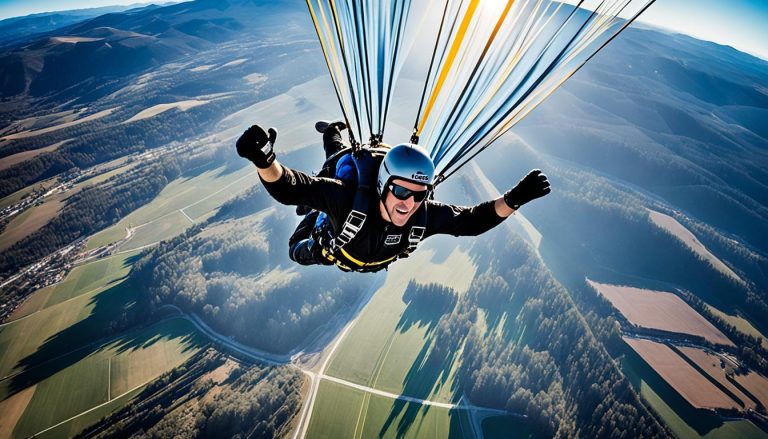The Thrill of Speed: Techniques for Faster Freefalls during Parachuting
Do you crave the exhilarating sensation of speed during a skydiving freefall? Imagine the rush of wind against your face as you plummet through the sky, defying gravity. If you’re looking to take your parachuting adventures to new heights, it’s time to explore techniques for faster freefalls during parachuting and discover parachute freefall tips that will accelerate your descent.
Skydiving is not merely about an adrenaline rush; it’s a perfect blend of science and thrill. By understanding the physics behind freefall, you can unlock the secrets to increasing your speed and mastering control in the air. From adjusting your body position to manipulating the relative wind, there are several techniques you can employ to achieve faster freefalls.
In this article, we will unravel the fascinating world of skydiving physics and delve into the skydiving speed techniques that will make your heart race. We will explore how to increase freefall speed while maintaining stability and safety. Prepare yourself for an adrenaline-fueled adventure as we dive into the science of skydiving and the techniques that will propel you to new horizons.
The Science of Skydiving
The science of skydiving delves into the realm of physics, specifically the study of matter in motion through space and time. When it comes to skydiving, one of the most thrilling aspects is the experience of freefall, where an object descends purely under the influence of gravity. During this exhilarating moment, the body encounters the awe-inspiring thrill of speed.
Terminal velocity, the maximum speed achieved during a freefall, is a delicate equilibrium between gravity and air resistance. Understanding the physics behind skydiving allows enthusiasts to explore techniques that can be employed to amplify the speed experienced in freefall. By honing these skills, skydivers can attain a more thrilling and dynamic descent.
One vital aspect of skydiving speed is the concept of terminal velocity. When a skydiver jumps from an aircraft, they accelerate due to gravity until the resistance from the surrounding air begins to balance out the gravitational force. At this point, the skydiver reaches terminal velocity, where the upward force exerted by the air equals the downward pull of gravity. This state of equilibrium ensures a stable descent and a consistent speed for the duration of freefall.
“Understanding the physics of skydiving is essential for achieving maximum speed and control during freefall,” says Dr. Amelia Rodriguez, a renowned physicist and avid skydiver. “By implementing proper techniques, skydivers can enhance their experience and push the boundaries of speed.”
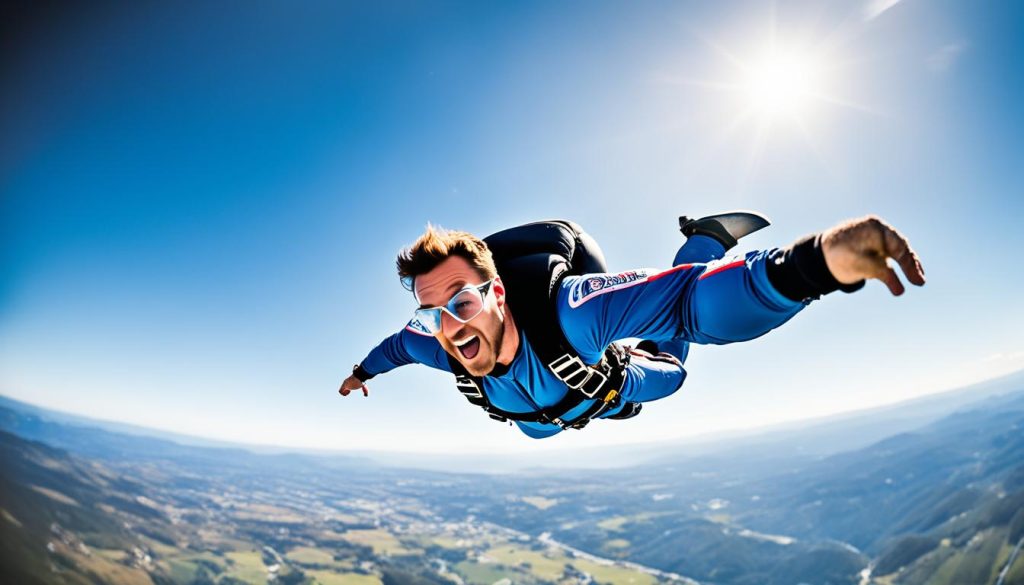
The Physics of Skydiving Speed Techniques
To increase the speed experienced during freefall, skydivers can employ various techniques that optimize body position and aerodynamics. Some of these techniques include:
- Streamlined Body Position: Maintaining a streamlined body posture by arching the back and keeping the arms and legs close to the body reduces air resistance, allowing for faster descent.
- Head Down Position: By shifting the body orientation to a head-down position, skydivers can harness the increased aerodynamic efficiency, thus achieving higher speeds during freefall.
- Use of Dive Loops: Skillfully executing dive loops, which involve creating a circular path while descending, enables skydivers to generate additional speed while maintaining control.
- Equipment Optimization: Utilizing specialized equipment such as wingsuits or high-performance parachutes designed for increased speed can significantly enhance the overall freefall experience.
“Implementing these techniques requires practice, experience, and a thorough understanding of the physics at play,” advises Dr. Rodriguez. “Skydivers should undergo proper training and consult with experienced instructors to ensure they can safely explore the realms of increased freefall speed.”
“By applying the principles of aerodynamics and body positioning, skydivers can actively manipulate their speed during freefall, creating an exhilarating and adrenaline-pumping experience.”
As skydiving enthusiasts delve deeper into the science of the sport, they unlock a realm that combines the laws of physics with the pure thrill of speed. By mastering the techniques and principles discussed above, skydivers can enhance their freefall experience and push the boundaries of what is possible.
Parachute Physics
Parachute physics is a critical aspect of the skydiving experience. Parachutes are designed based on the principles of flight for small fixed-wing aircraft. The shape of the parachute, resembling an airfoil, plays a crucial role in creating an aerodynamic force that allows skydivers to control their descent.
“Understanding parachute physics enables advanced techniques for enhancing skydiving speed.”
According to Bernoulli’s principle, the faster air on top of the parachute decreases the air pressure, creating lift. This lift force enables skydivers to not only descend but also maneuver and have control over their flight. By leveraging the principles of flight, advanced parachuting techniques can be employed to optimize skydiving speed.
“Parachute physics is the key to unlocking the full potential of skydiving acceleration methods.”
By considering the design of the parachute, skydivers can make adjustments to the shape, size, and trim of the canopy to achieve faster acceleration and descent. Additionally, understanding the aerodynamic properties of the parachute enables skydivers to execute advanced techniques such as controlling forward speed, performing spirals, and executing precise landings.
Parachute Physics Techniques for Skydiving Acceleration
| Technique | Description |
|---|---|
| Wing Loading | Increasing the wing loading by using a smaller parachute allows for a faster descent. |
| Body Positioning | Different body positions can modify the airflow and redirect it, enabling quicker forward movement. |
| Canopy Shape | The canopy’s shape affects drag, lift, and stability, and choosing the ideal shape can enhance acceleration. |
| Brake Input | Mastering the use of the parachute’s brakes allows for controlled changes in descent speed. |
By incorporating these advanced parachuting techniques, skydivers can experience the thrill of higher acceleration and speed, pushing the boundaries of their freefall experience.
How Fast Do You Go in the Skydiving Freefall?
The speed of a skydiving freefall can vary based on several factors. These factors include body position, weight, altitude, and even air temperature and humidity. Different disciplines of skydiving, such as wingsuiting and speed skydiving, can also result in varying freefall speeds. While tandem skydiving typically reaches a speed of around 120 mph, other techniques can push the limits even further. The exhilarating sensation of speed during a freefall is enhanced by the sound of rushing wind and the feeling of the relative wind against the body.
Freefall speed is a thrilling aspect of skydiving that adds to the overall experience. Whether you’re a first-time skydiver or a seasoned enthusiast, exploring techniques to increase velocity can further elevate the excitement. Skilled skydivers harness the power of gravity and adjust their body position and movements to maximize speed and control during the descent. These skydiving velocity techniques, combined with the rush of the freefall, create a truly unforgettable adventure in the sky.
How Exactly Do You Freefall in the Air?
Freefall in the air is much more than simply jumping and falling. It’s a dynamic experience that involves harnessing the power of the wind to control movement and enhance skydiving speed. By understanding the art of positioning and maneuvering the body, skydivers can achieve fast freefall maneuvers and take their exhilarating adventure to new heights.
Beginners in skydiving start with a flat or belly flying position, arching their bodies like a shuttlecock to maintain stability and control. This position maximizes the surface area and creates minimal air resistance, allowing for a smoother descent. It’s important to find the right balance between stability and speed.
As skydivers gain experience and confidence, they can progress to more advanced maneuvers and movements. With proper body positioning and control, they can enhance their speed and maneuverability during freefall. Techniques such as forming a slight head-down or head-up position, adjusting the arms and legs, and utilizing the relative wind can make a significant difference in enhancing skydiving speed.
| Freefall Maneuver | Benefits |
|---|---|
| Head-down position | Increases the surface area facing the relative wind, resulting in faster freefall speeds. |
| Head-up position | Creates more drag, allowing for better control and slower descent. |
| Leg and arm adjustments | By altering the position and angle of the legs and arms, skydivers can fine-tune their speed and stability during freefall. |
| Utilizing the relative wind | Skydivers can angle their bodies to use the wind to their advantage, gaining extra speed while maintaining control. |
It’s important for skydivers to remember that while fast freefall maneuvers can bring excitement and an adrenaline rush, safety should always be a top priority. Proper training, supervision, and adherence to safety protocols are essential.
Enhancing skydiving speed through advanced freefall maneuvers requires practice, experience, and a deep understanding of body control. As skydivers delve into the art of fast freefall, they unlock new possibilities for thrilling experiences in the world of parachute sports.
Taking Your Know-How to New Heights
The physics of skydiving can be understood and applied by anyone, without requiring advanced scientific knowledge. Taking the time to learn about the science behind skydiving can enhance the experience and provide valuable insights into achieving faster freefalls. Whether it’s through tandem skydiving or pursuing a skydiving license, the journey of exploring the physics of skydiving will take your knowledge and skills to new heights.
Understanding the principles of skydiving acceleration methods and parachuting velocity techniques can significantly impact your freefall experience. By applying these techniques, you can maximize your speed and control during the descent, making each jump more exhilarating than the last.
When it comes to skydiving acceleration, body position plays a crucial role. By adjusting your body to minimize air resistance, you can increase your velocity during the freefall. Tucking your arms and legs close to your body creates a streamlined position, reducing drag and allowing for faster maneuvering through the air.
Another effective method for accelerating during a skydive is to perform advanced freefall maneuvers. By learning techniques such as tracking or diving, you can use gravity to your advantage, rapidly increasing your speed as you descend. These techniques require practice and expertise, but they offer a thrilling way to push the limits of your skydiving experience.
In addition to acceleration methods, understanding parachuting velocity techniques is essential for achieving faster freefalls. Parachutes are designed to maximize control and speed during the descent. By adjusting the canopy’s shape and surface area, you can manipulate air resistance and increase your velocity.
Furthermore, harnessing the power of the relative wind can greatly enhance your skydiving speed. By utilizing the airflow created during freefall, you can maneuver your body to accelerate in specific directions. Skilled skydivers can perform turns, dives, and other advanced maneuvers to propel themselves through the air at impressive speeds.
Table: Top Skydiving Acceleration Methods and Parachuting Velocity Techniques
| Acceleration Methods | Velocity Techniques |
|---|---|
| – Streamlined body position | – Adjusting parachute canopy shape |
| – Performing advanced freefall maneuvers | – Utilizing the relative wind |
| – Minimizing air resistance | – Maneuvering for increased speed |
By combining these skydiving acceleration methods and parachuting velocity techniques, you can take your freefall experience to new heights. The thrill of achieving faster speeds and experiencing the rush of adrenaline will make each jump a truly unforgettable adventure.
So, whether you’re a seasoned skydiver looking to enhance your skills or a beginner eager to embrace the physics behind skydiving, don’t miss the opportunity to explore the world of acceleration and velocity. The knowledge you gain will propel you into an exciting realm where speed and control meet the exhilaration of the open sky.
Conclusion
Skydiving freefall is an exhilarating experience that combines the forces of gravity and air resistance. Understanding the physics behind freefall and parachute flight allows skydivers to maximize their speed and control during the descent. By employing techniques such as adjusting body position, surface area, and utilizing the relative wind, skydivers can enhance the thrill of freefall and increase their speed and maneuverability.
Embracing the science of skydiving opens up a world of exciting possibilities for enthusiasts seeking faster and more exhilarating freefalls. Whether you’re a beginner or an experienced skydiver, taking the time to learn about the physics behind skydiving can greatly enhance your overall experience. So why wait? Take the plunge and embark on the thrilling journey of faster, more thrilling freefalls during your next parachuting adventure.
Experience the unparalleled thrill of freefalling through the sky and discover the remarkable sensation of defying gravity. Increase your freefall speed with expert techniques and enjoy the exhilaration that comes with mastering the physics of skydiving. Be prepared to embrace the rush, the adrenaline, and the sheer joy that comes with experiencing the thrill of freefall at its finest.

